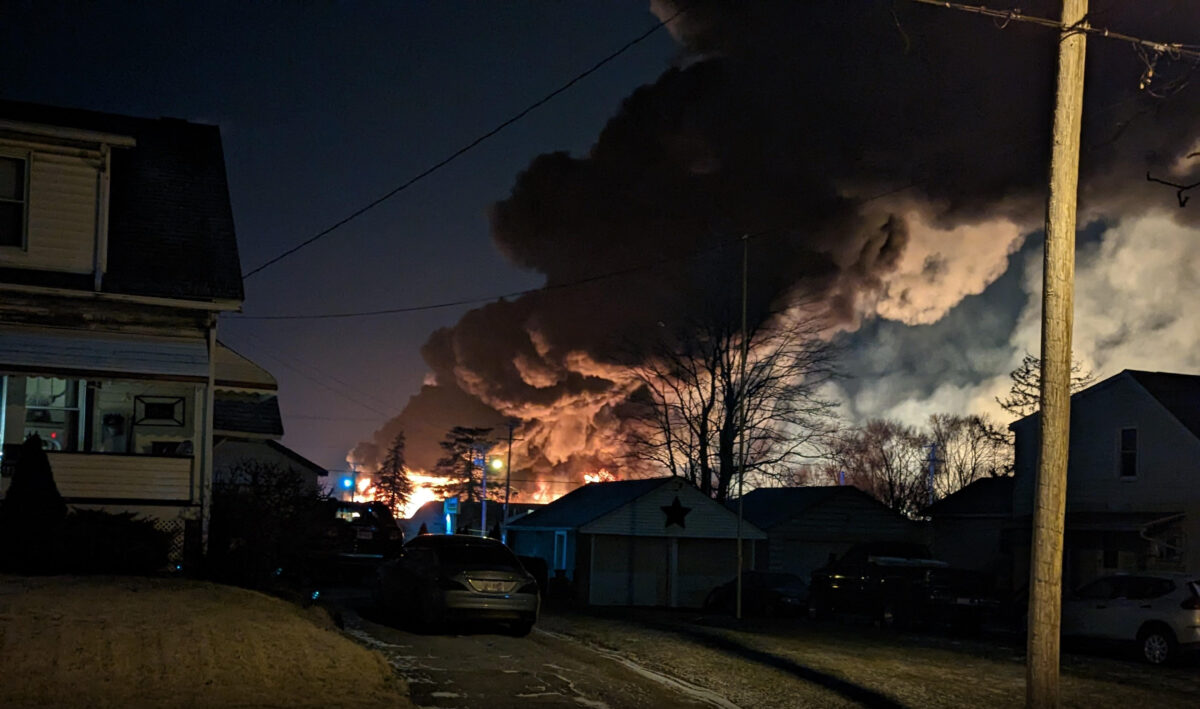During a discussion Wednesday about the $600 million Norfolk Southern agreed to pay to settle a string of lawsuits stemming from the company’s disastrous derailment in East Palestine, Ohio, Lonnie Miller paused to think of the eclipse that had plunged the area into a brief moment of darkness a few days earlier. The world seemed to stop while everyone gazed skyward, then the light quickly returned, and everyone resumed their daily activities.
For Miller and many others whose lives have been upturned since Feb. 3, 2023, the toxic train derailment served as an eclipse that plunged their lives into a darkness that just won’t go away. The world watched in horror as TV images showed heavy black clouds rising over the town. Then the cameras departed and everyone moved on with their lives — except those who’ve had to live with the derailment’s consequences.
“It’s still there no matter where I look,” Miller said. The flames she saw the night of the crash continue to haunt her. “I stand in my driveway and I see a blue sky, but those fires are still there in my mind. It doesn’t go away, and I want it to go away.”
Will the settlement, announced on Tuesday, chase away Miller’s recurring fiery visions? She doesn’t think so. The costs to residents are too high, and the amount offered is too low. Norfolk Southern has spent nearly $1 billion on cleanup, she noted. “Are residents’ lives worth less than that?” she asks.
She’s not the only skeptic. The settlement was a hot topic in East Palestine and the surrounding communities. A Facebook group devoted to residents affected by the derailment lit up with comments slamming the deal. And on Wednesday morning, the Unity Council for East Palestine Derailment offered its opinion. It wasn’t favorable.
“How can you make an offer when people are still being exposed and you still don’t know the extent or results of that exposure?” it read. “No one knows what low level multiple chemical exposure does, as no studies have been done on this sort of thing.”
East Palestine resident Chris Albright did a quick calculation and figured that the amount of money won’t help much once it’s divided up among residents and businesses, attorneys fees are deducted, and residents pay taxes on the amount they receive.
“To me, it’s a slap in the face,” he said. “600 million? It doesn’t seem right, it doesn’t sit well.”
Attorneys representing plaintiffs in the case that led to the settlement tried to address residents’ concerns during a Zoom news conference early Wednesday afternoon.
“We understand that perspective,” said attorney Seth Katz of the law firm Burg Simpson Eldredge Hersh & Jardine. “I would ask them to be patient and work through the process with us and learn more before casting a final judgment of whether or not this is the right settlement for them.”
As for the $600 million figure, it was reached during a process involving a mediator — retired federal Judge Layn Phillips — and months of negotiation, the attorneys said.
The attorneys kicked off the news conference by praising the settlement. It was an “outstanding result,” said M. Elizabeth Graham of Grant & Eisenhofer.
Katz said plaintiffs in the suit were consulted and advised during the process, and “they are all very happy with the outcome. They understand how we got here.”
The settlement makes relief a possibility for all those living within a 20-mile radius of the derailment. Who will get the money and how much? The attorneys said funds will be allocated based on a number of factors — proximity to the derailment and Feb. 6 burn off of chemicals, the number of people in the household, whether children live in the home, whether an individual worked in the community.
“We’re working with financial experts to translate that into dollars,” said Graham. “It’s a fair and impartial process that is designed to compensate those folks affected the most with the highest values.”
Businesses will be eligible — they’ll be asked to show tax returns to determine losses caused by the derailment.
Before anything happens, though, the settlement must receive preliminary approval from U.S. District Court Judge Benita Pearson of Youngstown. Once that happens — attorneys said approval could some as soon as month’s end — those eligible will be contacted by mail. Notices will also air on television and appear on social media. The attorneys said town meetings will be scheduled to explain the details, and help will be available at the family assistance center in East Palestine. Graham said they were “erring on the side of being over inclusive.”
People who receive notification will be asked to answer a series of questions on a claim form to determine eligibility.
Of course, several East Palestine-area residents worry most about future health risks. They certainly rise to the top of Chris Albright’s concerns — and for good reason. He and his family live half a mile from the derailment site. Doctors diagnosed him with a heart condition a year ago; his cardiologist believes chemicals from the derailment, or stress, likely exacerbated his condition. In May, his wife, Jessica experienced stroke-level blood pressure.
“What about later on down the road?” Albright asked. “This isn’t going to cover anything that happens down the road. We don’t know what this is going to do later on to our kids. Are they going to have reproductive problems? Will they get cancer?”
The settlement attempts to address those concerns -— but with a catch. The deal includes a voluntary program that compensates people in a 10-mile radius for personal injuries resulting from their exposure to chemicals released during the derailment and burn off. Those to accept this compensation, however, would be ineligible for future claims.
Eligible residents will have to make a personal decision about whether this is right for them, the attorneys said.
“As you probably know, the latency period for a lot of these chemicals and the risk to the community, according to our experts, is not as great as we feared,” said attorney Jayne Conroy of Simmons Hanly Conroy. “If there are individuals that unfortunately do get sick, it will be years from now, so the payment would cover those future expenses. We’re also going to be putting the community in touch with people who will help manage a portion of the money so that it is in a trust for them and it will grow, so if down the road something happens, they will have been compensated and will have money for health care.”
• • •
Talk in town the past few days focused on financial compensation, but Lonnie Miller was quick to point out that not all costs borne by residents are monetary. She mourns the loss of community, as neighbors and friends move away from town. Then there’s the PTSD that she and others experience, and the stress she feels when she hears the rumble of passing trains.
“There are so many different layers to this,” she said. “It impacts every single part of your life. There were moments last year when Dave and I were at each other’s throats, and we have a strong relationship. I could see where it could break us. It could absolutely break a strong marriage. It infiltrates everything.”
In the months after the derailment, the Millers doubted the safety of their house on East Clark Street, 1,800 feet from “ground zero.” Lonnie Miller experienced crushing headaches and nosebleeds. So they put the home on the market, took out a mortgage and bought a house in Leetonia, 15 miles away.
The East Clark home remained on the market for months with buyers showing little interest. Twice the Millers lowered the price. A few weeks ago they accepted an offer that was lower still (the sale has yet to be finalized). They felt they had little choice — they were paying insurance and electric bills on two places. Plus, their Leetonia house needs a new roof, and perhaps a new furnace — the existing one has been acting up. The Millers used a wood stove to heat the house this past winter.
“We’re starting over again,” Lonnie said. “We’ve got a debt we didn’t have 15 months ago. But we’ve kept our family safe, away from the chemicals.”
The timing of the settlement with Norfolk Southern seems suspicious to her. She wonders if it has something to do with public hearings. In late March, she and several others testified about the impact of the derailment at a Darlington, Pennsylvania, hearing conducted by Pennsylvania state Sen. Doug Mastriano, R-Franklin County, and the National Transportation Safety Board will hold its final board meeting on the derailment on June 25.
“I think they’re just trying to get rid of this before the final report comes out,” she said. “I think they know so much more damning information will be released.”
After doing a television interview Wednesday morning, Unity Council president Jami Wallace noticed her skepticism showed when discussing the settlement. “I have to watch my facial expressions,” she said. “I’m rolling my eyes.”
Afterward, she focused her thoughts on the unknowns — namely, the lack of research on the risks of exposure to the stew of toxic chemicals in the black clouds that hung over the area last year. The symptoms people are now experiencing — the bloody noses, the headaches, the vomiting — are real, she said, and should not be ignored.
“Look at our bodies,” she said. “Look at the rashes on our children. When do they listen to the people?”
Steve is a photojournalist and writer for the Pittsburgh Post-Gazette, but he is currently on strike and working as a Union Progress co-editor. Reach him at smellon@unionprogress.com.



